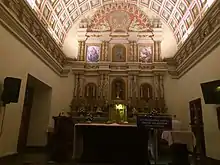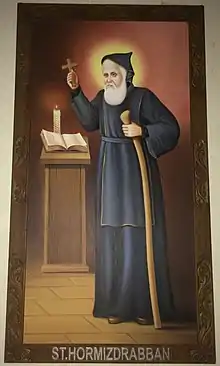Mar Hormizd Syro-Malabar Church, Angamaly
Mar Hormizd Syro-Malabar Catholic Church, Angamaly is a church located in Angamaly, Kerala, India. It was established in 1570 by Mar Abraham, the last Chaldean Metropolitan to reach Malabar Coast.[4] It is dedicated to Mar Hormizd, a seventh-century Chaldean saint.[5][6]
| Mar Hormizd Syro-Malabar Catholic Church, Angamaly | |
|---|---|
 Madbaha of Mar Hormizd Syro-Malabar Church, Angamaly | |
 Mar Hormizd Syro-Malabar Catholic Church, Angamaly | |
| 10.1906°N 76.3828°E | |
| Location | Angamaly, Kerala |
| Country | India |
| Denomination | Catholic (Syro-Malabar Catholic Church)[1] |
| Tradition | East Syriac Rite |
| History | |
| Former name(s) | Mar Hormizd Metropolitan Cathedral |
| Status | Filial[2] |
| Founded | 1577[3] |
| Founder(s) | Mar Abraham, Metropolitan and the Gate of All India |
| Dedication | Hormizd Rabban |
| Dedicated | 1583[3] |
| Consecrated | 1583[3] |
| Cult(s) present | former cathedral of Saint Thomas Christians |
| Relics held | Mar Abraham |
| Past bishop(s) | Mar Abraham |
| Associated people | Saint Thomas Christians |
| Administration | |
| Archdiocese | Syro-Malabar Catholic Major Archeparchy of Ernakulam-Angamaly |
| Clergy | |
| Archbishop | Mar George Alencherry |
History
Mar Abraham who came to Malabar in 1570 settled in Angamaly as his See to govern the Saint Thomas Christians. Its jurisdiction was extended whole over India till the 16th century. The most ancient University for Malpan training was established at Angamaly before the arrival of the Portughese. The Chaldean bishop Mar Abraham was ordained as the Metropolitan and the Gate of All India and Rabban Hormiz Church was the Cathedral church.[7][8] This title denotes a Quasi Patriarchal status with all India jurisdiction.[9][10][11]
The church houses the tomb of Mar Abraham who died in 1597.[12][13]
Mar Hormizd Church, built by Mar Abraham
After having made a successful escape from the Portuguese detention in Goa, Mar Abraham returned to Angamaly in 1570. In the same year, Mar Abraham built his first Cathedral Church namely Rabban Hormizd, a seventh-century Abbot of the East Syriac Church, as its patron.
In 1578, as a response to the requests made on the part of the Jesuit missionaries who had been working in Angamaly and in the other centres of the Christians of St. Thomas, the pope sent plenary indulgences to the Church of Rabban Hormizd which the faithful could obtain four times a year for 25 years from the year of the election of the Metropolitan Mar Abraham. The indulgences covered two feasts of the Patron Rabban Hormizd that fell on the fifteenth day after Easter (Monday) and on the first of September. On 15 August 1579, as requested by Mar Abraham, the Jesuits laid the foundation stone of a new Cathedral Rabban Hormizd in the same place that was chosen by the Metropolitan.
Gallery
 Exterior of the church
Exterior of the church Tomb of last East Syriac Metropolitan Mar Abraham inside the Madbaha of Mar Hormizd Syro-Malabar Church, Angamaly
Tomb of last East Syriac Metropolitan Mar Abraham inside the Madbaha of Mar Hormizd Syro-Malabar Church, Angamaly Image of Rabban Hormizd at Mar Hormizd Syro-Malabar Church, Angamaly
Image of Rabban Hormizd at Mar Hormizd Syro-Malabar Church, Angamaly
References
- "St. Hormis Church, Angamaly East". Syro-Malabar Church. Retrieved 1 July 2018.
- "Archived copy". Archived from the original on 10 November 2014. Retrieved 18 November 2014.CS1 maint: archived copy as title (link)
- "Consecration of renovated Mar Hormiz Church, Angamaly". Deepika. Retrieved 7 January 2016.
- Encyclopaedia of sects & religious doctrines, Volume 4 By Charles George Herbermann page 1180,1181
- Fr. Varghese Pathikulangara CMI (2011). Divine Praises in Aramaic Tradition (PDF). Kottayam: Denha Services. p. 48. ISBN 978-93-81207-02-4.
- "Archived copy". Archived from the original on 1 February 2012. Retrieved 18 November 2014.CS1 maint: archived copy as title (link)
- Du Jarric, tom. I, lib. II, p. 614
- Du Jarric, "Rer. Ind. Thesaur.", tom. III, lib. II, p. 69
- Joseph Thekkedathu, pous cit pp96-100
- Rev Dr Placid Podipara, The Hierarchy of Syro Malabar Church, in Collected works of Rev Dr Placid Podipara CMI, Vol I p 719
- For full details cf. the many passages in the Thomapedia, 1973/2000, Ed.George Menachery
- Language of religion, language of the people: medieval Judaism, Christianity, and Islam,Ernst Bremer, Susanne Röhl Page 401
- http://www.nasrani.net/2007/07/31/book-reviewthe-nazranies-by-prof-george-menanchery/
